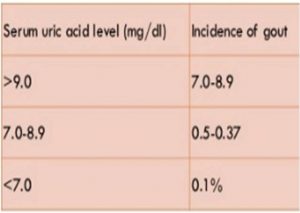
Gouty Arthritis (Rheumatism Due to Uric Acid)

Artritis gout is an inflammation of the joints caused by deposits of uric acid crystals in the joints. This disease occurs due to impaired purine metabolism. Purines are proteins that are metabolized in the body into uric acid. The normal uric acid level for men is 7 mg% while for women it is 5.1 mg%. Uric acid levels in the body come from food and body metabolism, most of which will be excreted from the body through urine. Uric acid levels in the body will increase if: input (eating) a lot of purines, production increases and its output or excretion is disturbed.
WHO CAN GET GOUT?
Gout can be categorized as:
- Primary gout is hyperuricemia caused by insufficient uric acid excretion from the body or excessive uric acid production. This occurs due to: impaired uric acid metabolism, high purine diet.
- Secondary gout is hyperuricemia caused by medications or other diseases such as blood cancer.
Now let's talk about primary gout only. Not everyone will suffer from gout, only those with risk factors will get gout.
RISK FACTORS
Risk factors are conditions that can lead to hyperuricemia or gout, including: family history (genetic), obesity (obese), age & gender, foods that contain many purines and chronic diseases. A person with a family history of gout is at risk for developing gout, as is obesity. Sex and age, men suffer from gout more often than women, mostly men aged 30-50 years and women after menopause.Certain foods can cause an increase in uric acid.Chronic diseases that risk gout are: diabetes, high fat levels (cholesterol and triglycerides) and decreased kidney function.
SYMPTOMS
The most commonly affected joint is the big toe, other joints in the foot can also be affected, with complaints of sudden and severe pain in the middle of the night or early in the morning, the pain reaches its peak a maximum of 12 hours from the onset of pain. The affected joints are purplish-red in color, swollen and painful, with even touching being painful. This attack can occur repeatedly so that there can be deposits of uric acid crystals under the skin called tofus. This tofus may rupture.

TREATMENT
Treatment of gouty arthritis consists of :
- Treatment for the pain, which can be done by oral administration (through the mouth = taken by mouth) or injections.
- Treatment for prevention by changing lifestyle and giving medicine.
Treatment and prevention of this disease should be under the supervision of a doctor.
PREVENTION
Since uric acid is excreted from the body mostly through urine, the simplest way is to drink a lot and avoid foods with high purine content. Foods that contain a lot of purines include: hay; meat (beef, mutton, pork, chicken); sea fish (shellfish, shrimp, lobster, sardines, mackerel, haremis); beer and other liquors; drinks with high fructose content (soda, some juices, ice cream, etc.); vegetables (asparagus, spinach, cauliflower, beans, mushrooms, peas).
Prevention to avoid subsequent attacks can be done by lowering the level of uric acid in the blood This is done if gout attacks in a year more than twice (not every time uric acid levels are more than normal) and this method should be done under the supervision of a doctor, to achieve the desired results and to avoid unwanted things.
The relationship between serum/blood uric acid levels and the occurrence of gouty arthritis:

COMPLICATIONS DUE TO GOUT
- Deposition of urate micro-crystals under the skin.
- Renal failure, due to the formation of urate stones in the kidneys or micro-deposits of urate crystals in the hair channels (tubules) of the kidneys.
- The onset of other chronic diseases such as high blood pressure and coronary heart disease.
CONCLUSIONS AND SUGGESTIONS
- Gout is a disease caused by the accumulation of uric acid crystals in the joints, and the joints most commonly affected are the ibujari joints.
- Attacks generally occur in the middle of the night or before dawn.
- These gout attacks often recur, therefore prevention must be taken, by avoiding risk factors, if necessary, uric acid levels must be lowered with medication until they reach a certain level.
- Not all patients with uric acid levels above normal should be lowered with medication. To reduce uric acid levels with drugs has a special procedure and should be under the supervision of a doctor.



